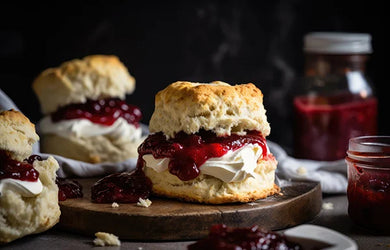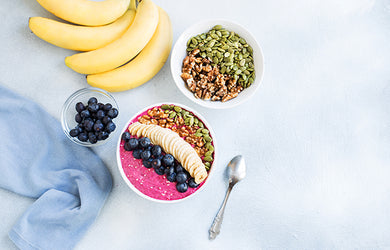clotted cream is renowned for its smooth texture that pairs perfectly with jam, creating an irresistible topping for scones. however, this gem from the south-west of england, may not be easily available everywhere. no worries! next time you crave classic scones, there’s no need to go hunting for this amazing cream – you can craft it easily at home.
we can assure you that crafting this cream at home involves an easy process and allows you to enjoy its amazing flavour. and not just on the scones, you can enjoy this cream by spreading it on an array of baked treats – from bread to biscuits. interesting, right? let’s explore what is clotted cream and how it transforms ordinary dishes into gourmet treats.

what is clotted cream?
clotted (or scalded) cream is a sumptuously thick and rich british dairy product believed to have its origins in southwest england. this amazing spread has become a hallmark of traditional afternoon teas, not just in england but in several places around the world.
this delicious spread is made by gently heating cream, and then allowing it to cool slowly. during this process, the cream rises to the surface and creates thick, velvety clots. the result is a luxurious spread with a high butterfat content, typically around 55%, surpassing that of regular heavy cream.
the rich cream has a slightly sweet flavour and closely resembles the taste of high-quality unsalted butter. moreover, it has subtle nutty notes that develop from the extended cooking time. this tasty cream has an equally interesting texture. it’s characterised by a grainy consistency and clots on its surface, having a resemblance to the richness found in creme fraiche or mascarpone.
now that we've got the answer to what is clotted cream, let’s move further.
how to make clotted cream
we'll guide you through the making steps with our detailed clotted cream recipe, making it easier for you to enjoy this treat at home. let’s get down to learning how to make clotted cream.
Total Servings:-
12
Preparation Time:-
5 Minutes
Cooking Times:-
12 minutes
Nutritional Value:-
123 calories, 14g fat, 1g carbs, 1g protein
Recipe Category:-
Spread or Topping
Cuisine:-
british
equipment:
- a large bowl or small ramekins
ingredients
- 450ml heavy cream
here are all the steps of our clotted cream recipe.
instructions
preheat the oven: to prepare this dish, it's essential to use an oven that must be preheated before you begin. set the temperature to 80°c and allow the oven to heat up while you focus on other aspects of your preparation.
pour the cream into ramekins: now, carefully divide the heavy cream equally among the three ramekins/small bowls. you can use one spacious oven-safe container, instead, if you like. the goal is to achieve a depth of 1½ to 2 inches of cream, regardless of the dish.
bake the cream: after placing the cream in the dish, verify whether the oven has completed its preheating process. if it has, place the ramekins on an oven tray for stability, then transfer them to the middle shelf of the preheated oven. allow the cream to bake for 12 hours undisturbed. although the cooking duration might appear extensive, there's a rationale behind it. the extended period of gentle heating in the oven facilitates the evaporation of certain liquids and lets the rich portion rise to the surface.
cool the cream: once the 12 hours are complete, get the cream out of the oven and let it cool completely at room temperature. although the cream may seem slightly liquid at this stage, it will thicken as it cools.
refrigerate the cream: cover the dish and place it in the refrigerator. let the cream chill for at least 8 hours (about 12 hours for the best results). while the waiting period may seem prolonged, be reassured that the amazing cream will more than justify that.
remove excess liquid: when you take the cream out of the fridge, use a spoon to lift an edge of the cream layer. pour into another container any liquid that may have collected below the thick layer of cream. mix everything remaining together. if the cream is too thick for your liking, you can spoon some of the liquid back into it.
preserve the golden crust: it’s likely that a golden layer forms on the surface of the cream. do not scrape it off as it adds a unique flavour when mixed with the cream. so, go ahead and do that.
serve and enjoy: your homemade scalded cream is now ready to be enjoyed. serve it alongside freshly baked scones, pastries or any baked goods of your choice. the rich, velvety texture and exceptional flavour will enhance your teatime to an unmatched level.
utilise whey (optional): it's worth noting that the liquid transferred to another container is indeed whey. yes, it’s very useful, so feel free to repurpose it in baking scones or other culinary creations.
we trust that the process offers a clearer insight into what is clotted cream and how it’s made.
using clotted cream in traditional tea
this luxurious and smooth delight completes the traditional tea experience by bringing in a rich and indulgent touch. clotted (or scalded) cream is the perfect one to be paired with jam for warm scones. let’s explore how you can properly enjoy scones with jam and cream during a traditional tea gathering.
first, scoop out the cream and jams onto your plate from the little containers served at your table. use the provided spoons for each of the containers to avoid cross-contamination. now, with your plate ready with jam and cream, break a scone horizontally into half with your hands or a knife (better to use hands), and use the knife to generously slather on jam and then cream. and remember not to make a scone sandwich – each part is meant to be eaten separately with jam and cream.
why not go ahead and give it a shot? your tea moment awaits a touch of cream perfection!
clotted cream vs whipped cream
both the creams are amazing dairy toppings but they’ve several differences in flavour, texture, production and culinary application.
major differences
fat content: clotted (or scalded) cream has around 55% fat, which surpasses the fat content of whipped cream, which hovers around 30% to 40%.
flavour: clotted cream features a subtle sweet and nutty flavour while whipped cream tends to be relatively neutral in taste. however, flavour enhancement can be done in both of them.
texture: while heavy cream acts as a base for both creams, their method of preparation is different – resulting in different textures. whipped cream is aerated into airy peaks, whereas the other one has a dense texture resembling that of butter.
production: scalded cream is formed through a gradual heating process followed by several hours of chilling. it takes around 20 hours to make this cream. however, whipped cream is produced by vigorous whisking or using an electric mixer to beat the cream until it thickens.
tips for the perfect clotted cream recipe
heavy cream: steer clear of ultra-pasteurised cream as the heat treatment affects the results; opt for pasteurised or, ideally, unpasteurised if available.
monitor oven: keep an eye on your oven occasionally, especially if there’s no provision to set the temperature to the required 80°c. additionally, ensure there are no hot spots in the oven, as higher temperatures at some places may lead to the browning of the cream.
avoid excessive cream: whether using one large dish or multiple smaller ones, maintain a cream depth of 1 ½-2 inches.
chilling step: remember not to skip this step as it’s crucial for achieving the desired thickness and consistency of the cream.
skimming: skim gently and avoid mixing the excess liquid (whey) to preserve the cream's thickness and consistency.
patience pays: preparing this cream takes a lot of time – 12-hours of heating period and then an additional time of around 8-10 hours for chilling. therefore, you must plan ahead to ensure it's ready when you need it.
faqs on clotted cream
Q. how long does homemade clotted cream stay fresh?
A. the clotted cream can stay fresh for up to two weeks if it’s stored in a sealed container and then placed in the refrigerator. proper refrigeration helps preserve the rich texture and flavour of the cream for amazing creations in your kitchen.
Q. can i use clotted cream in desserts other than scones?
A. this cream's smooth texture and rich flavour make it a versatile ingredient for various desserts. you can use it as a topping for pies, cakes or fruits as well as in recipes for ice cream. this cream adds a luxurious touch to a wide range of sweet treats.
Q. how long does it take to make clotted cream?
A. making clotted cream at home takes around 12 hours of slow heating in the oven at a low temperature. it’s followed by an additional 8-10 hours of cooling and chilling in the fridge. while it requires time, the process is relatively simple, and the result is well worth the wait.
Q. what are some common mistakes to avoid when making clotted cream?
A. a couple of common mistakes to avoid are – overheating and skimming. overheating at higher temperatures leads to excessive browning, which can be prevented by monitoring the oven and looking out for any hot spots. with regards to skimming, sometimes it’s not done properly, and the separated liquid gets re-mixed.
1 comment
- Liquid error (sections/main-article-recipe line 159): Could not find asset snippets/comment.liquid

























































